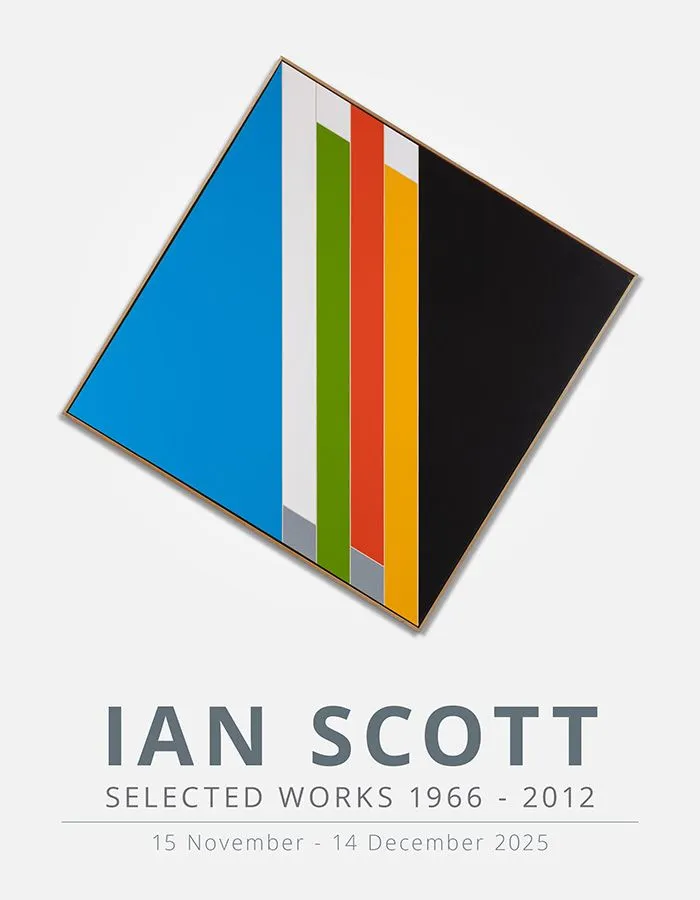Ian Scott: Selected Works 1966 - 2012 (2025)
Closes
Dec 14, 2025Posted on
Nov 7, 2025Event type:
Art , Exhibition , Public Art , Public Program ,Price:
FreeVenue:
Milford GalleriesAddress:
58 Gorge Road, QueenstownRegion:
National , Online , Otago ,
“Because the same person is doing the work, Scott feels that eventually the connections between different styles will become apparent.” ¹
Selected Works 1966–2012 surveys Scott’s painting career, revealing the unity behind his remarkable evolution, innovation, and stylistic transformations. Despite shifts in style, these are unmistakably the works of the same artist, linked by both formal characteristics and theoretical concerns. A bold, bright palette evoking New Zealand suburbia, overlapping elements, sharp geometries, large scale, and playful illusionistic space are visually evident alongside a deep interrogation of national identity and value, the intersection of tradition and change, and what it means to live and paint in New Zealand.
Conceptually, while deeply engaged with the art discourses of his time, Scott underwent three major shifts in his painting practice over five decades. The first was his engagement with international Pop Art and the development of a distinctly New Zealand contemporary or “New” Realism, beginning while he was still at art school. The second was his exploration of Modernism, which culminated in his most recognisable Lattice series. Finally, he turned toward Postmodernism, embracing appropriation and the re-examination of images, the conventions of painting, and the myths embedded in the New Zealand landscape tradition.
While still at art school, Scott was influenced by American Pop Art, using appropriation and contrast as fundamental pictorial devices. In Untitled (1966), he ironically brings together the seemingly incompatible: the picturesque New Zealand tourist landscape (possibly Mitre Peak), a vignette of Auckland overlooking the harbour with a blooming pōhutukawa, and a portion of a weatherboarded house. With its playful juxtapositions and triangular geometries, this work foreshadows his forthcoming series and lifelong preoccupation with the relationship between figuration and abstraction.
Weaving together familiar colours and forms to create a distinctive abstract language of Aotearoa, Scott’s Lattices are iconic. In Selected Works 1966–2012, Scott’s very early Lattice No. 35 (1978) is exhibited alongside one of his last, Small Lattice No. 427 (2013), remarkably similar in composition and colour palette. In the intervening Lattices, Scott introduced the monochrome, diamond, grid, and chevron, demonstrating how a seemingly simple motif could sustain complexity through repetition and serve as an endless source of inspiration over the decades.
Scott’s move towards postmodern concerns gave him the forum to meld realism, abstraction, and cultural commentary. In Nor’wester in the Cemetery (1987), Scott explores the grandeur and value of landscape painting in a larger-than-life reinterpretation of Bill Sutton’s iconic scene. Drawing on formal conventions established in his Lattices, he strategically uses gold and grey lettering to both obscure and animate the image beneath, creating a dynamic interplay between physical and illusionistic space.
In works such as Hill of Gold (2004), Scott brings Colin McCahon and other figures from New Zealand art history literally into the frame, juxtaposing the real and the constructed, and questioning lineage, legacy, and the role of the artist in shaping New Zealand’s identity and culture.
Selected Works 1966–2012 brings together, for the first time, key paintings from Scott’s major series, offering a clear view of his wider artistic vision. A painter of relentless drive and curiosity, Scott continually pursued new challenges, seeking to position New Zealand painting within an international context while remaining deeply grounded in the realities of suburban life, local light and landscape.
1. Warwick Brown, Ian Scott Paintings 1986-1989, Centre for Contemporary Art, Hamilton, New Zealand, 1993, p 7.